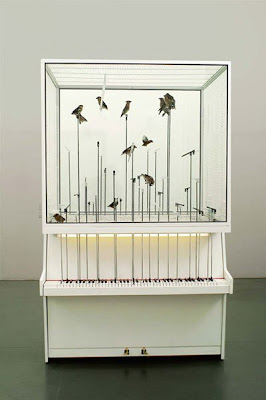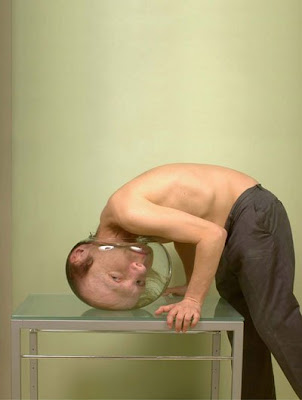Thursday, December 31, 2009
Tuesday, December 29, 2009
The Splendorous Form of Noise
The above is a compilation of works by the Swiss artist Zimoun.
1. Funny, one keeps telling oneself, enough of the minimal already, somehow feeling that less is a bore should be embraced, and the outrageously overflowing art of the recent years - appreciated and encouraged. And then, something like this appears, and it's irresistible. We've seen things from this universe before, also on this blog, and yet, the simplicity, yes, the damn purity takes over again.
2. I had a chance, recently, to visit several large factories. There were wonders there that could probably match most of the things on this video. Yet there was one thing they couldn't do: be useless. It's the sheer uselessness of it that gives it the power. We are not attached to anything but the thing. Art as the thing-that-cannot-be-used? Not necessarily, not in some purist sense. Great industrial design is to be cherished. And yet, there is a level of insanity here, of out-of-this-world-ness, that takes us to an exotic land, allowing for the silliest and most delicious connections to be made.
3. Luxury requires waste. A truly luxurious lifestyle is one where perfectly good things get wasted, as if to outplay their natural use and dying away. The true master of luxury seems to be saying her opulence is so great, the very perseverence of things is no match - they lose their original function and only exist to the extent they are participating in this out-of-this-world-ness of luxury.
You know what I'm aiming at? Here's the hypothesis:
4. This, this minimalist joyful pleasure-making, is the true luxury. Not the apparent richness of the new complexities. In the world of useless purity, everything only serves the joy of simple aesthetic pleasure. More complex works are not quite like that - they have an inner game to play. The elements enter a dialogue, start relations and societies, with their conflicts and functions and disruptions. Here, there is only the ping of a shot of pleasure. This engine moves nothing. It is here to make me smile (or bring inspiration, or scare) - and I turn it off as soon as I have. And don't be mistaken - if I had one of those and got bored with and could afford it, it would go to waste.
4a. Ah, you might say, but the truly great art is one we don't get bored with. Possibly. Yet how often do we actually go back to contemplate (not just think about or admire or analyze) a work of contemporary "minimalist" art? Does it mean it's because it's not that great? What if it's about something else? What if it is an element of luxury, a game we play with ourselves, to feel the exquisite taste of the sophisticated dish, and then to ditch it as soon as we're fed up? It wouldn't be a question of bluff, of fakeness, of shallowness. It would be a question of use. Of why we crave it, this new. Of how we make it useful after all.
 David Foldvari, Wrestler
David Foldvari, Wrestler
(via)
Saturday, December 26, 2009
Wishing you aesthetic pleasure
 Gabriel Cornelius von Max, Monkeys as Judges of Art (1840)
Gabriel Cornelius von Max, Monkeys as Judges of Art (1840)(I'm the small one watching the work, the one in the middle, whose profile can be seen behind the bent knee)
Monday, December 21, 2009
Earn your money


 The Minimum Wage Machine (work in progress), by Blake Fall-Conroy
The Minimum Wage Machine (work in progress), by Blake Fall-ConroyThe minimum wage machine allows anybody to work for minimum wage. Turning the crank will yield one penny every 5.04 seconds, for $7.15 an hour (NY state minimum wage). If the participant stops turning the crank, they stop receiving money. The machine's mechanism and electronics are powered by the hand crank, and pennies are stored in a plexiglas box.
Contrary to some other art experiments on work (I'm thinking of some of Santiago Sierra's early projects, but had I any memory, I'm sure a dozen other works would come to my mind), this, here, is not about objectifying labor. It takes the paradox of work-as-product in a somewhat different direction. If there is a minimum wage, any job should be paid the minimum wage. So turning the handle should actually always give you this result.
You can read a technical description of how it was constructed (didn't understand half of it) here.
Sunday, December 20, 2009
Wink

UPDATE: It is The Cyclops by Jaime Pitarch (2002)
Thank you Claudia!
Friday, December 18, 2009
Does beauty make sense?
And does beauty differ dependent on categories? After all, we do watch differently than we listen. And when we watch, the pleasure of, say, seeing a beautiful feature film is quite different from the pleasure of seeing a piece of video art. And although of course the merging and the postmodernism and the over-all mishmash exists in discourse, the categories are still quite strong, our (my) attitudes vary tremendously depending on what I'm watching. It's a tricky area, tagging. But the fact that it's tricky should only encourage to explore, no?
Between from Via Grafik on Vimeo.
(via)
Tuesday, December 15, 2009
Omniphilia

 The first image seems the most banal. But we'll get back to it.
The first image seems the most banal. But we'll get back to it.The second is clearly far from innocent. Or rather, it is its absolute innocence that brings the tension.
Just one more innocent painting to keep you off-guard...

And here we go:

 Most of Melissa Steckbauer's spicier pictures are somewhere along the lines of the above. They are people in erotic/sexual situations with animals, realistic or mythical ones. Now, how in the world can she include the first painting you see here (the bear-girl) in the same series, Animalia, as the ones you've just seen?
Most of Melissa Steckbauer's spicier pictures are somewhere along the lines of the above. They are people in erotic/sexual situations with animals, realistic or mythical ones. Now, how in the world can she include the first painting you see here (the bear-girl) in the same series, Animalia, as the ones you've just seen?That is precisely what gives the series such power. They demistify us by including us in the myth. This human animal becomes a being of flesh. Of flesh and myth. This teddy bear is the same girl that's having sex with the dog, moving away from the otherness as it penetrates her. Better: she and the beast are one flesh. They are no different, as if in peace with their unbearable similarity. Look at the man with the bear. What is this? A killing? Could it possibly be a hug? No, it is a hug, be it intended or not. It is flesh, it is warm and cuddly. And foreign. Although harmonious - Steckenbauer insists that for her the crucial issue in terms of eroticism is ethics, which she seems to oppose to a set of taboos. But is there really no taboo? No hidden, dangerous zone? To the contrary, the further she goes, the more mysterious and ambivalent the universe. What is this animal, and how does one distinguish it from oneself?



In the interview at the end of this post, Steckbauer talks about her appreciation for "meat in the painting". And for softness and gentleness. And one of my favorite works of hers combines these two. It is somewhat different from the others, reminding me of Man Ray, maybe. What can we do, it says, what can we do if this is the touch of flesh, the touch that seems to go through my body, to immobilize us as it multiplies the members and gets us way out into oblivion, a communication made ambiguous, an identity lost, or repainted, or foresaken, for the sake of what, of what, oh don't ask me, enjoy.

PS: I dedicate this post to the memory of my aunt, whom I first had the chance to speak to when I was 17. We spoke on the phone (she lived in another country). Her very first words to me were: "Hello young man! How are you? How is your sex life?"
(via)
Monday, December 14, 2009
Munching Sweets


From the Towers
by Heather McHugh
Insanity is not a want of reason.
It is reason's overgrowth, a calculating kudzu.
Explaining why, in two-ton manifesti, thinkers sally forth
with testaments and pipe bombs. Heaven help us:
spare us all your meaningful designs. Shine down or
shower forth, but (for the earthling's sake) ignore
all prayers followed by against, or for. Teach us to bear
life's senselessness, our insignificance, and more;
let's call that sanity. The terrifying prospect isn't some
escapist with a novel, fond of comfort, munching sweets—
it is the busy hermeneut, so serious he's sour, intent on making
meaning of us all, and bursting from the towers to the streets.
Paintings by Hegyusz.
Wednesday, December 09, 2009
The Disappeared
The majority of the desaparecidos still remain missing.
What made me enquire into all this was a photographic project called Ausencias ("Absences", 2007) by Gustavo Germano.
Yes, the people who disappear from the photos are cases of the desaparecidos.

---
Maria Irma Ferreira
.
---


Sunday, November 22, 2009
The Song Is You
Call us romantic. Call us Those Who Couldn't Stand The Progress And Stepped Back.Retrograded, taking the easy way out, exploring the (music's, world's, history's) feedback.
Yet feedback is not the sound that comes back to its source. It is not the echo. It is the echo used as an input.
Thus, what you call feedback is the mere beginning, the source material of the process of creation. As the world comes back crumbling to the imperfection of our ever-childish senses, our feeble gestures, breaking through our inherited self-irony, make things possible. Better, they give us back the light.
Too light? Too naive?
Would you prefer this?
The Gospel was right: The meek shall inherit the Earth. Actually, they've inherited it already. Along with the self-irony, they took what was most precious, and what many deemed lost - the damn aura. Yes, the damn aura still shining and glowing through all the mechanical reproductions. We still want their bloody flesh, we still want to know this is where it's at, right here, between the stage and you, between the song and you.
x x x
All this crossed my mind when watching the brilliant The Song Is You festival at Powiększenie in Warsaw recently.
The song that stayed with me the most was simple.
Here it is:
Do you get it? Beyond the gorgeous lyrics, can you feel how it was, listening to it in the club basement, with the grand piano behind Momus, the lights, the weekend dying away? Or can you imagine it? How different is the song you hear from mine?
More on the festival here. Don't miss tonight (12.03), the last part of the festival, with Kyst and AU.
Sunday, November 15, 2009
Past Present




No, I will not be writing about how the ever-present cameras turn us into monsters. Or about consumerism versus culture.
What interests me here, to start with, is how we position ourselves in relation to the past.
What is given to us is not merely a luggage - a heritage that is like an object. It is an ever-eroding landscape. And each person has her own map she may or may not use to rebuild it, or rather, to build herself into it.
Watch these bodies. These figures. Watch how they open a dialogue they are not aware of. Watch how they become, that's it, a sign.
Maybe the most dramatic is the last one, the young man lying on the ground, his hands close to his face. Forget his camera. Now, what do you see?
Or maybe the most dramatic is the first, black figure, that is watching birds through binoculars, or a plane, or he could almost be shouting a friendly greeting to someone standing on the roof... were it not the seemingly anonymous bricks behind him. Were it not our maps. And now, with your map, what do you see? Who is hitting him? Shooting?
Or rather, what is he, what are they protecting themselves against?
What makes a sign a sign?
When does it signify, lead to the signified? How does the arrow gain its shape? How is it born?
How much of these vectors is rooted in us so deeply, we spell it out with every word, unknowingly?
Take this much less spectacular project by William Boling, called Never Gone. Boling took photographs of the places in Atlanta where the Battle of Atlanta occurred in July 1864.



So what makes a sign a sign?
When does it signify, lead to the signified? How does the arrow gain its shape? How is it born?
How much of these vectors is rooted in us so deeply, we spell it out with every word, unknowingly?
How To Win An Art Contest In One Easy Step
Tom Polo created the 2009 B.E.S.T. Contemporary Art Prize for Painting contest. The criteria were typical of the art contests we know. Except for one small point, which stated:
eligible entrants are artists born on the 1st February, 1985 and named as 'Tommaso Polo' on their birth certificates.
The exhibition of the finalists (guess who?) is taking place at the MOP gallery in Sydney.
The winning work, by - you guessed it - Tom Polo, is called Continuous One Liners (Young People Today).
 Possibly many of my dear readers are thinking, we've had similar ideas, but they were too childish to execute. Maybe the most seductive part of tricksters is that by putting to life the silliness we only imagine (or think we imagined), they at once make it more serious and much more ridiculous.
Possibly many of my dear readers are thinking, we've had similar ideas, but they were too childish to execute. Maybe the most seductive part of tricksters is that by putting to life the silliness we only imagine (or think we imagined), they at once make it more serious and much more ridiculous.You can find an interview with the artist at The Art Life.
Why B.E.S.T.? Because Everybody Still Tries.
Tuesday, November 03, 2009
Anonymous. 3 works by Armin Rohr



I can't get these pictures out of my head.
Especially the last one is mesmerizing. Is it peaceful? Mysterious? Haunting? Creepy? Brutal?
The mass in the first two paintings that makes up a threatening, or at least disquieting block, is here replaced by three distinct figures. The space is neither claustrophobic, as in the first one, nor agoraphobic, as could be claimed about the second (notice the ceiling moving up above the horizontal line that "closes" the picture). In the third picture, the space is abstract. It is the water we often feel is the closest to the sky. So what's the matter? Maybe it's the skyish space combined with the strokes, the juicy, dripping pinks that get feverish in the center? Maybe it's the unfaceness of these faces? The ghost should be ephemeral, translucid. Yet here, the ghosts are opaque. They are thick with body. And moving in.
All works are by Armin Rohr, found on his blog.
Sunday, November 01, 2009
If You Want To Cry

My Mother, My Son by Mary Frey
And another one, less obvious, but no less gorgeous - Bathroom Landscape:
 Every once in a while the question comes back lurking: are there things that are not to be shown? Or rather: not to be worked at? Do you imagine this - a woman standing in the room with a camera, waiting for the right moment so she can take a picture of her son carrying her mother? Hold her up just a bit honey... Just a little more...
Every once in a while the question comes back lurking: are there things that are not to be shown? Or rather: not to be worked at? Do you imagine this - a woman standing in the room with a camera, waiting for the right moment so she can take a picture of her son carrying her mother? Hold her up just a bit honey... Just a little more...And yet, this is one of the most touching pictures I have seen in quite a while.
(via)
Zoonoia

...and the most unappealing digital album of 2007 - Ready Made. Which is also an accomplishment of sorts.
Tuesday, October 27, 2009
In A Sentimental Mood

Sonnet 44
If the dull substance of my flesh were thought,
Injurious distance should not stop my way;
For then despite of space I would be brought,
From limits far remote, where thou dost stay.
No matter then although my foot did stand
Upon the farthest earth removed from thee;
For nimble thought can jump both sea and land
As soon as think the place where he would be.
But, ah, thought kills me that I am not thought,
To leap large lengths of miles when thou art gone,
But that, so much of earth and water wrought,
I must attend time's leisure with my moan,
Receiving nought by elements so slow,
But heavy tears, badges of either's woe.
(Shakespeare)
One more thing: The bone in the film is a wishbone:
The wishbone, known in anatomy as the furcula, is a sternum bone found in birds which is shaped like the letter Y. It is used as an attachment point for the wing muscles. It is so named because of a tradition: Two people pull on each side of such a bone, and when it breaks, the one who gets the larger part is said to have a wish granted.
The mechanical sculpture in the film is by Arthur Ganson. Some of his stuff is really awe-inspiring. Check this Machine with Artichoke Petal #2
Of course, it may bring to mind other art machines (Rebecca Horn, but also manyothers), but what I really appreciate here is the simplicity. Modest art is something to be cherished. It also reminds me of some of the musical experiences by the Portuguese musician Nuno Rebelo:
Even the really simple ones are really something: Machine with Chinese Fan
Is it kitsch? I don't care.
(via)
Monday, October 26, 2009
Workingg
- As found, a site with images found on the net... Fantastic.
- The wonderfuly anarchist Tex Server.
- And some of Marc's animations can be found here.
Saturday, October 24, 2009
The right and the rights
 So how was it for YOU?
So how was it for YOU?Not all of Robert Grigolov's work convinces me. Some of it seems like simple tricks pour épater les bourgeois. But isn't part of the fun about discovering the value something has for you when taking out of a context which isn't necessarily one you appreciate?
 Why does the above installation have the title Dollar Bill? I don't know. I have some ideas, but I don't think I want to follow them. And, just as Daniel Pennac's 10 Inalienable Rights of the Reader, so any spectator has similar rights, among them, to decide arbitrarily where the work begins and ends for her.
Why does the above installation have the title Dollar Bill? I don't know. I have some ideas, but I don't think I want to follow them. And, just as Daniel Pennac's 10 Inalienable Rights of the Reader, so any spectator has similar rights, among them, to decide arbitrarily where the work begins and ends for her. This doesn't need to mean any sort of glorification of ignorance. However, it does accept it as part of the deal. After all, the spectator is no less free than the artist, is he?
This doesn't need to mean any sort of glorification of ignorance. However, it does accept it as part of the deal. After all, the spectator is no less free than the artist, is he? This should be a very obvious question. Aesthetic relativism is something seemingly accepted. Yet the contemporary art world seems to specialize in "right" ways of looking at its creations.
This should be a very obvious question. Aesthetic relativism is something seemingly accepted. Yet the contemporary art world seems to specialize in "right" ways of looking at its creations. Anything goes - yet there is still plenty of exciting space for dialogue. Tastes are indeed something we discuss and shape, aesthetic experience is a beautifuly shapeable thing. And yet one of the most difficult things is to stay within the play of common value-seeking and exploration of personal experience, and not move into the discourse of competence, the universe of authority, which might sustain a big chunk of what the contemporary art world is about, but is hardly enjoyable for those of us who like their artflesh stupendously raw and intimate.
Anything goes - yet there is still plenty of exciting space for dialogue. Tastes are indeed something we discuss and shape, aesthetic experience is a beautifuly shapeable thing. And yet one of the most difficult things is to stay within the play of common value-seeking and exploration of personal experience, and not move into the discourse of competence, the universe of authority, which might sustain a big chunk of what the contemporary art world is about, but is hardly enjoyable for those of us who like their artflesh stupendously raw and intimate.(via)
Wednesday, October 21, 2009
Watch your back




Oh what jealousy of the physical difference! Of the outcasting cast out in flesh! Oh how simple the definitions then become. How meaningful in their ever-presence. What sort of a tragedy can there be when its shape is nothing? How do you give it shape? How do you translate it into something it is not?
All pictures are by Risk Hazekamp.
Wednesday, October 14, 2009
Art after commerce
And here's a commercial product present since 1989:
Classic questions:
How much of the value is the originality of the project?
How much is there left for the concept? The execution? The richness of the universe that is being created? The "art codes"?
The bluff?
Should one stop/diverge a project upon realizing one is following another's path too closely?
This latter question is quite recurrent among many of the artists I know. Some opt for stopping, while others simply don't let go of their toy. After all, they say, isn't it always mine in the first place? Unintentional plagiarism? So what? If you focus on what you are, on your own path, shouldn't it always lead to an original work? In the best of possible worlds?
Monday, October 12, 2009
The Wild Things Are In Forts





 Some of my favorites from the Wild Things' Forts contest by Booooom, where you can send in your picture of a fort....
Some of my favorites from the Wild Things' Forts contest by Booooom, where you can send in your picture of a fort....Here's the explanation:
Where The Wild Things Are is filled with references to building a world out of things from your everyday life and that’s exactly what we want you to do!
We want you to create a fort! Use garbage bags, tree branches, tablecloths, prosthetic limbs, wood, gold, whatever you got!
Snap a photo, and email it to me, here.
Winner gets a “Wild Things” Edition XBOX plus a magnificent bus shelter-sized Where the Wild Things Are poster not available in stores!
Contest ends next Monday (October 12th), so get on it!



